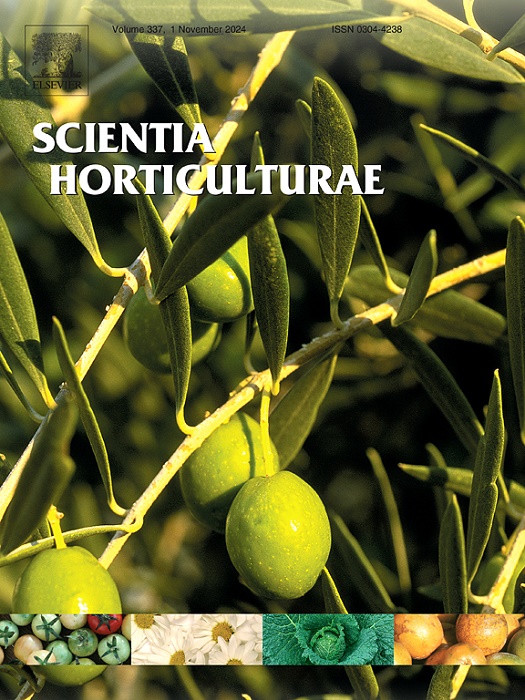水曲柳增芽增产的新途径及其机理。
IF 3.9
2区 农林科学
Q1 HORTICULTURE
引用次数: 0
摘要
水曲柳是中国北方珍贵的木材和园林树种。然而,其无性系繁殖面临着幼母树出芽有限、接穗来源不足、产量低和利用周期短等重大挑战。本文介绍了一种新的促进水曲柳发芽的方法,重点研究了树干扦插、连续年轻化和叶片修剪等因素。该方法首先确定了树干切割的最佳条件,考虑了树龄、高度和时机。然后,满足这些条件的植株依次进行覆膜、基部环植和激素喷雾回春处理。在芽枝收集期间进行叶片修剪。结果表明,对于4岁以上的树木,在春季液流后3周,在离地30 ~ 50 cm处进行树干扦插处理,然后再进行年轻化处理(套筒+基环+激素喷洒),可使扦插产量提高10.4倍。此外,在枝条采收时,在基部保留一对腋芽,同时去除复叶,可使扦插产量额外增加47.1%。这种方法有效地促进了苗木的发芽,产生了适合繁殖的插枝。为了进一步阐明水曲柳扦插后芽再生的促进机制,对水曲柳扦插后芽再生过程中的激素水平和关键基因表达进行了分析,鉴定出了水曲柳芽再生关键基因FmESR1。用FmESR1转化水曲柳下胚轴,获得过表达的转基因植株。结合不定芽发育、激素水平和再生相关基因表达的变化,发现FmESR1在不定芽再生中起着至关重要的作用。由此可见,促芽通过激活FmESR1的表达,显著提高了幼苗的再生能力和扦插产量。该技术为水曲柳优良新品种的高效繁殖和推广应用奠定了坚实的基础。FmESR1功能的阐明不仅丰富了对茎部再生的理论认识和基因功能数据库,而且为无性繁殖提供了理论和技术支持。本文章由计算机程序翻译,如有差异,请以英文原文为准。
A novel approach for enhancing sprouting to increase yield and its mechanism in Fraxinus mandshurica Rupr.
Fraxinus mandshurica is a valuable timber and landscaping tree species in northern China. However, its clonal propagation faces significant challenges, including limited sprouting of young mother trees, insufficient scion sources, low yields and short usage cycles. This study introduced a novel method to promote sprouting in F. mandshurica, focusing on factors like trunk cutting, continuous rejuvenation and leaf trimming. The method initially determined the optimal conditions for trunk cutting, considering tree age, height, and timing. Plants that met these conditions were then subjected to coppicing, basal girdling and hormone sprays rejuvenation treatments in sequence. Leaf trimming was conducted during sprouting branches collection. The results showed that for trees over 4 years old, trunk cutting treatment was performed 30∼50 cm above the ground 3 weeks after sap flow in spring, followed by rejuvenation treatment (coppicing + basal girdling + hormone sprays), which improved the cutting yield by 10.4-fold. Furthermore, retaining a pair of axillary buds at the base while removing the compound leaves during branch harvesting can increase cutting yield by an additional 47.1 %. This approach effectively promoted sprouting and produced cuttings suitable for propagation. To further elucidate the mechanism of sprouting promotion, the hormone levels and key gene expression during shoot regeneration after F. mandshurica trunk cutting were analyzed, leading to the identification of the key shoot regeneration gene FmESR1. By transforming the F. mandshurica hypocotyl with FmESR1, overexpressing transgenic plants were obtained. Combined with the changes in adventitious shoot development, hormone levels and regeneration-related gene expression, it was revealed that FmESR1 played a crucial role in shoot regeneration. Thus, it was concluded that sprouting promotion significantly improved regeneration ability and cutting yield by activating the expression of FmESR1. This technology lays a solid foundation for the efficient reproduction and widespread application of superior and new varieties of F. mandshurica. The elucidation of FmESR1 function not only enriches the theoretical understanding of shoot regeneration and the gene function database but also provides theoretical and technical support for asexual propagation.
求助全文
通过发布文献求助,成功后即可免费获取论文全文。
去求助
来源期刊

Scientia Horticulturae
农林科学-园艺
CiteScore
8.60
自引率
4.70%
发文量
796
审稿时长
47 days
期刊介绍:
Scientia Horticulturae is an international journal publishing research related to horticultural crops. Articles in the journal deal with open or protected production of vegetables, fruits, edible fungi and ornamentals under temperate, subtropical and tropical conditions. Papers in related areas (biochemistry, micropropagation, soil science, plant breeding, plant physiology, phytopathology, etc.) are considered, if they contain information of direct significance to horticulture. Papers on the technical aspects of horticulture (engineering, crop processing, storage, transport etc.) are accepted for publication only if they relate directly to the living product. In the case of plantation crops, those yielding a product that may be used fresh (e.g. tropical vegetables, citrus, bananas, and other fruits) will be considered, while those papers describing the processing of the product (e.g. rubber, tobacco, and quinine) will not. The scope of the journal includes all horticultural crops but does not include speciality crops such as, medicinal crops or forestry crops, such as bamboo. Basic molecular studies without any direct application in horticulture will not be considered for this journal.
 求助内容:
求助内容: 应助结果提醒方式:
应助结果提醒方式:


